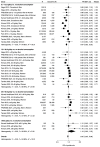A Dose-Dependent Association between Alcohol Consumption and Incidence of Proteinuria and Low Glomerular Filtration Rate: A Systematic Review and Meta-Analysis of Cohort Studies
- PMID: 37049433
- PMCID: PMC10097279
- DOI: 10.3390/nu15071592
A Dose-Dependent Association between Alcohol Consumption and Incidence of Proteinuria and Low Glomerular Filtration Rate: A Systematic Review and Meta-Analysis of Cohort Studies
Abstract
Previous cohort studies have reported conflicting associations between alcohol consumption and chronic kidney disease, characterized by proteinuria and low glomerular filtration rate (GFR). This systematic review, which included 14,634,940 participants from 11 cohort studies, assessed a dose-dependent association of alcohol consumption and incidence of proteinuria and low estimated GFR (eGFR) of <60 mL/min/1.73 m2. Compared with non-drinkers, the incidence of proteinuria was lower in drinkers with alcohol consumption of ≤12.0 g/day (relative risk 0.87 [95% confidence interval 0.83, 0.92]), but higher in drinkers with alcohol consumption of 36.1-60.0 g/day (1.09 [1.03, 1.15]), suggesting a J-shaped association between alcohol consumption and the incidence of proteinuria. Incidence of low eGFR was lower in drinkers with alcohol consumption of ≤12.0 and 12.1-36.0 than in non-drinkers (≤12.0, 12.1-36.0, and 36.1-60.0 g/day: 0.93 [0.90, 0.95], 0.82 [0.78, 0.86], and 0.89 [0.77, 1.03], respectively), suggesting that drinkers were at lower risk of low eGFR. In conclusion, compared with non-drinkers, mild drinkers were at lower risk of proteinuria and low eGFR, whereas heavy drinkers had a higher risk of proteinuria but a lower risk of low eGFR. The clinical impact of high alcohol consumption should be assessed in well-designed studies.
Keywords: alcohol consumption; chronic kidney disease; cohort study; dose-dependent association; glomerular filtration rate; meta-analysis; proteinuria; systematic review.
Conflict of interest statement
The authors declare no conflict of interest. The funders had no role in the study design; collection, analyses, or interpretation of data; writing of the manuscript; or decision to publish the results.
Figures



References
-
- Okada H., Yasuda Y., Kashihara N., Asahi K., Ito T., Kaname S., Kanda E., Kanno Y., Shikata K., Shibagaki Y., et al. Essential Points from Evidence-Based Clinical Practice Guidelines for Chronic Kidney Disease 2018. Clin. Exp. Nephrol. 2019;23:1–15. doi: 10.1007/s10157-018-1648-1. - DOI - PMC - PubMed
-
- GBD 2017 Risk Factor Collaborators Global, Regional, and National Comparative Risk Assessment of 84 Behavioural, Environmental and Occupational, and Metabolic Risks or Clusters of Risks for 195 Countries and Territories, 1990–2017: A Systematic Analysis for the Global Burden of Disease Study 2017. Lancet. 2018;392:1923–1994. doi: 10.1016/S0140-6736(18)32225-6. - DOI - PMC - PubMed
-
- Matsushita K., Coresh J., Sang Y., Chalmers J., Fox C., Guallar E., Jafar T., Jassal S.K., Landman G.W.D., Muntner P., et al. Estimated Glomerular Filtration Rate and Albuminuria for Prediction of Cardiovascular Outcomes: A Collaborative Meta-Analysis of Individual Participant Data. Lancet Diabetes Endocrinol. 2015;3:514–525. doi: 10.1016/S2213-8587(15)00040-6. - DOI - PMC - PubMed
Publication types
MeSH terms
Grants and funding
LinkOut - more resources
Full Text Sources
Medical
Research Materials
Miscellaneous

